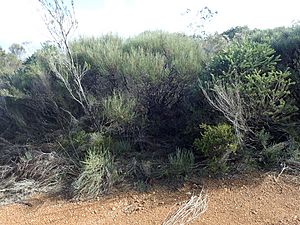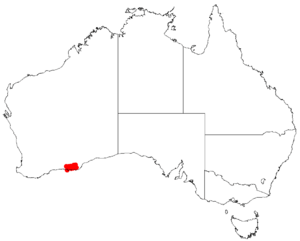Hakea bicornata facts for kids
Quick facts for kids Hakea bicornata |
|
|---|---|
 |
|
| Hakea bicornata in the Mount Burdett Nature Reserve | |
| Scientific classification | |
| Genus: |
Hakea
|
| Species: |
bicornata
|
 |
|
| Occurrence data from Australasian Virtual Herbarium | |
Hakea bicornata is a special shrub that grows in Western Australia. It belongs to the Proteaceae plant family. This plant is known for its lovely creamy-white flowers. It also has unique fruits that have two distinct "horns."
Contents
What Does It Look Like?
The Hakea bicornata is a shrub that can grow from about 0.8 to 2 meters (2.6 to 6.6 feet) tall. It has many stems and can regrow from a special woody base called a lignotuber if there's a fire.
Its smaller branches are a rusty color and have tiny hairs. The leaves are simple and also rusty-colored. They grow one after another along the stem. These leaves are usually 7 to 13 centimeters (2.8 to 5.1 inches) long. They are quite narrow, about 1.2 to 1.5 millimeters (0.047 to 0.059 inches) wide. Each leaf ends in a small point.
When the leaves are young, they are covered in soft, silky hairs. But as they get older, they become smooth.
Flowers and Fruit
This plant produces beautiful cream-white to yellow flowers. You can usually see them from April to May, and sometimes in August. Each group of flowers, called an inflorescence, has about eight flowers.
The flowers themselves are small, with a cream-white outer part (called the perianth) that's about 2.5 millimeters (0.098 inches) long. The part of the flower that helps make seeds, called the pistil, is about 4 millimeters (0.16 inches) long.
The fruits of Hakea bicornata are very interesting. They are oval or egg-shaped and measure about 15 to 22 millimeters (0.59 to 0.87 inches) long. They are also 12 to 15 millimeters (0.47 to 0.59 inches) wide. The most noticeable feature is a pair of narrow "horns" on each fruit. These horns are about 5 to 6 millimeters (0.20 to 0.24 inches) long.
The fruits are pale grey and have black, blister-like bumps on them. Inside, the seeds are dark brown to black and egg-shaped. Each seed has a wing along one side, which helps it fly away in the wind.
How It Got Its Name
The Hakea bicornata was officially described in 1990 by a botanist named R.M.Barker. She wrote about it in a scientific journal.
The plant's scientific name, bicornata, tells us something important about it. It comes from two Latin words. "Bi-" means "two" or "twice." And "cornu" means "horn." So, bicornata literally means "two-horned." This name perfectly describes the unique horns found on its fruit!
Where Does It Live?
You can find Hakea bicornata growing in coastal areas of Western Australia. Specifically, it lives in the Goldfields-Esperance region. This area is between the town of Esperance and Cape Arid National Park.
It likes to grow in sandy-loamy soils that contain laterite. These soils are often found over granite rock. The plant is part of the shrub-land communities that grow in these areas.
Is It Safe?
Good news! The Hakea bicornata is considered "not threatened" by the Western Australian Government's Department of Parks and Wildlife. This means it's not currently in danger of disappearing.
Images for kids



